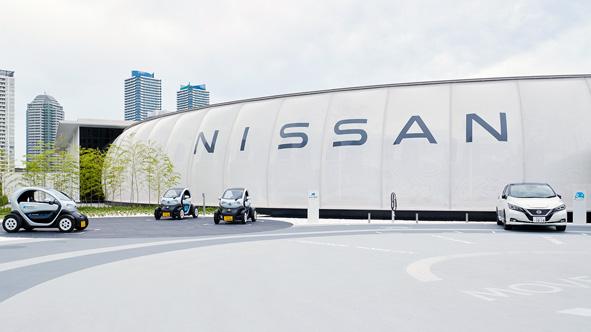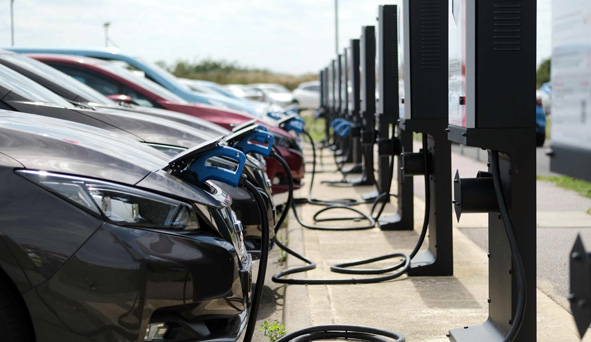Nissan lets drivers pay for parking with electricity
- August 11, 2020
- Steve Rogerson

Japanese car maker Nissan is giving its customers the ability to pay for parking with electricity.
Electric vehicle drivers will be able to discharge power from their car’s battery pack to pay for parking while visiting the Nissan Pavilion exhibition in Yokohama.
The payment system is one of various innovations at the pavilion. Visitors can eat at the Chaya Cafe, operating on power supplied by Nissan Leaf electric cars and solar energy. They can also enjoy virtual experiences that allow them to feel the thrill of Formula E electric street racing or go for a ride in the all-new Nissan Ariya EV crossover.
The 10,000-square-metre, zero-emission pavilion is outfitted with solar panels and supplied with renewable hydroelectric power.
“The pavilion is a place where customers can see, feel and be inspired by our near-future vision for society and mobility,” said Nissan CEO Makoto Uchida. “As the world shifts to electric mobility, EVs will be integrated into society in ways that go beyond just transportation.”
The company’s energy share and storage technologies allow electricity from EV batteries to be stored, shared and repurposed, for instance by powering homes or businesses, such as the off-grid cafe in the pavilion.
In Japan, Nissan has also entered agreements with local governments to use Leaf cars as mobile batteries that can supply energy during natural disasters. In another partnership, the company is repurposing used EV batteries to power streetlights.
As part of the Nissan Next transformation plan, the company intends to expand its global line of EVs and electric motor-driven cars, including e-Power. Nissan aims to sell more than a million electrified vehicles a year by the end of 2023.
Guests at the pavilion can also experience other innovations including the ProPilot advanced driver assistance system as well as Nissan’s invisible-to-visible (I2V) technology, which combines information from the real and virtual worlds to assist drivers.
By playing a virtual tennis match with Grand Slam champion and Nissan brand ambassador Naomi Osaka in the pavilion theatre, children and adults can learn about I2V and get a feel for how the technology will make driving more convenient, comfortable and exciting when it’s installed in cars in the near future.
In front of the pavilion, a mobility hub offers various services including EV car-sharing and rental bicycles. Offered by Nissan and the local community, these services aim to provide increased freedom of mobility.
• Energy utility E.On and Nissan have deployed 20 vehicle-to-grid (V2G) chargers as part of a trial to demonstrate how electric vans and cars could play a role in supporting the UK grid and provide a profitable and sustainable option for business fleets.

The install at Nissan’s European Technical Centre in Cranfield is the first in a large-scale V2G trial co-funded by Innovate UK. The project will test and demonstrate how storing and sharing electricity in fleet vehicles’ batteries can generate additional revenue for participating companies as well as supporting the power grid.
Having validated the technology at Cranfield, the project is now recruiting further participants for the trial and plans to deploy V2G chargers for organisations across the UK.
V2G technology allows electricity to flow in both directions to and from electric vehicle batteries, allowing energy stored in the battery to be sold back to the grid when demand for power is high. Vehicles can then charge when demand is lower or renewable generation is high, reducing reliance on fossil-fuelled generation, giving V2G a role in carbon reduction efforts.
The technology can also release capacity on the electricity networks, which distribute power around the country. In collaboration with UK Power Networks, the trial will go on to explore opportunities for customers to earn revenues from this as a service.
“Now that we’ve proven the technology’s capabilities with these 20 installs, we’re a step closer to bringing it to market,” said Luke Ellis, V2G programme manager with E.On. “This is about commercialising a vehicle’s bi-directional charging capabilities, with clear advantages for businesses either already with a fleet of electric vehicles or those that are ready to make the transition to electric, and demonstrates how E.On is providing for customers that will help make the air cleaner.”
Operating an electric fleet means already contributing to the net zero emissions target and saving money through local clean air zone exemptions. Integrating a fleet with V2G technology can brings cost savings and the chance to earn extra revenue. Fleet vehicles which sit idle overnight, or even during the working day, could see their batteries charged when demand is low, with the energy exported when demand is high, but still be charged and ready for use when required.
“V2G technology brings with it wider environmental benefits for society as a whole,” said Ellis. “It can be considered carbon negative for its potential to reduce or even remove the need for fossil-fuelled generation to be fired up at times of peak electricity demand.”
The V2G package for participants in the trial will be offered at a subsidised price through grant funding made available through Innovate UK. Vehicles compatible with the technology being used in this project are the Nissan e-NV200 and the Nissan Leaf.
“We know many fleets are not just looking at electric vehicle acquisition, they are also reviewing their energy infrastructure for a world where electric vehicles are fast becoming the norm,” said Peter McDonald, fleet director at Nissan Motor GB. “Nissan is collaborating with E.On on this exciting energy infrastructure project to expedite V2G technology in the UK. Thanks to the Leaf and e-NV200 being V2G-capable, these EVs are well set for the future.”
As well as E.On and Nissan, the V2G project consortium known as e4Future includes Newcastle University, Imperial College London, Northern Powergrid, UK Power Networks and National Grid ESO. The V2G platform used on the trial is a combination of E.On’s existing Virtual Power Plant software as well as a charger operating system provided by E.On’s e-mobility partner Virta.




